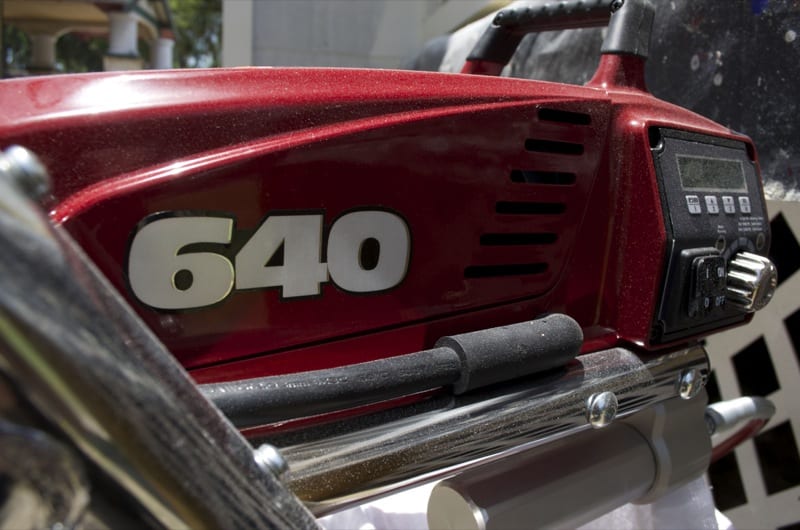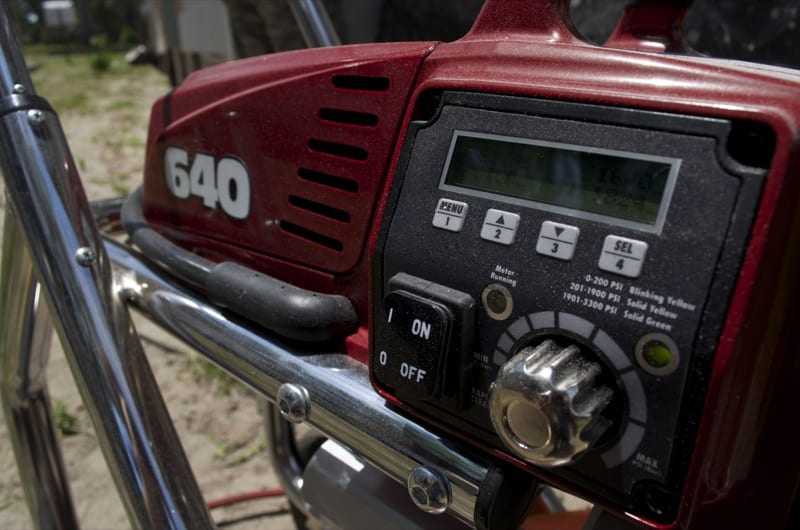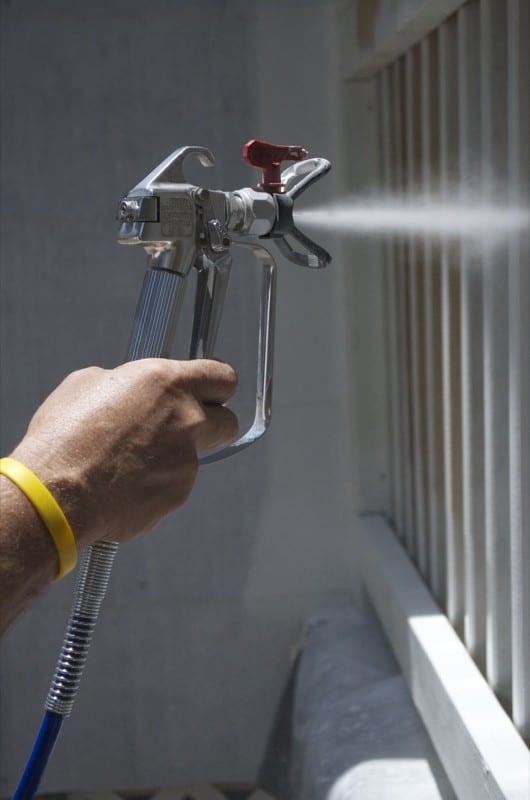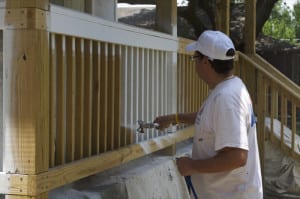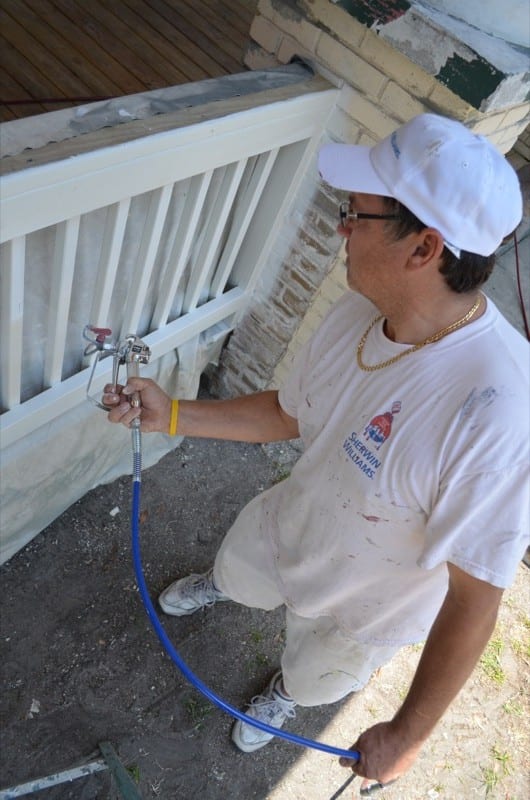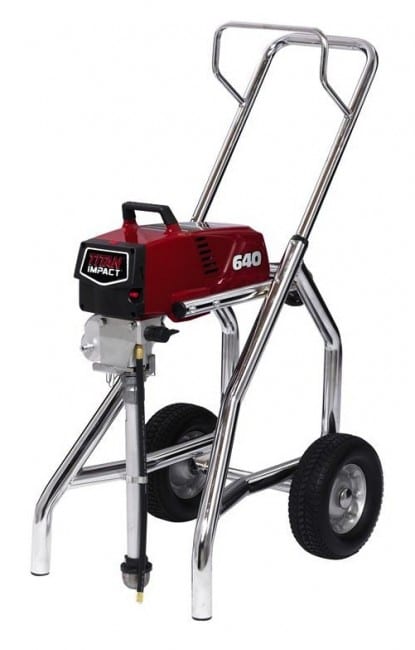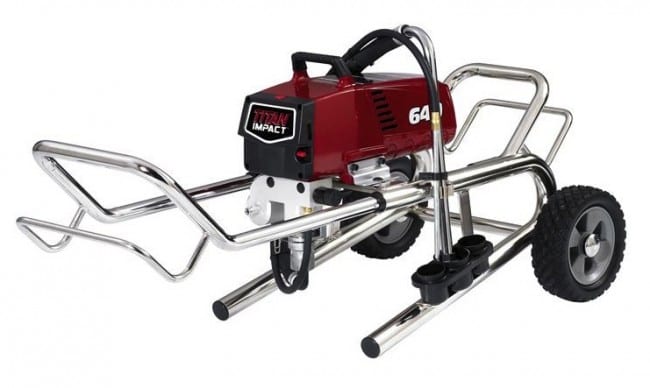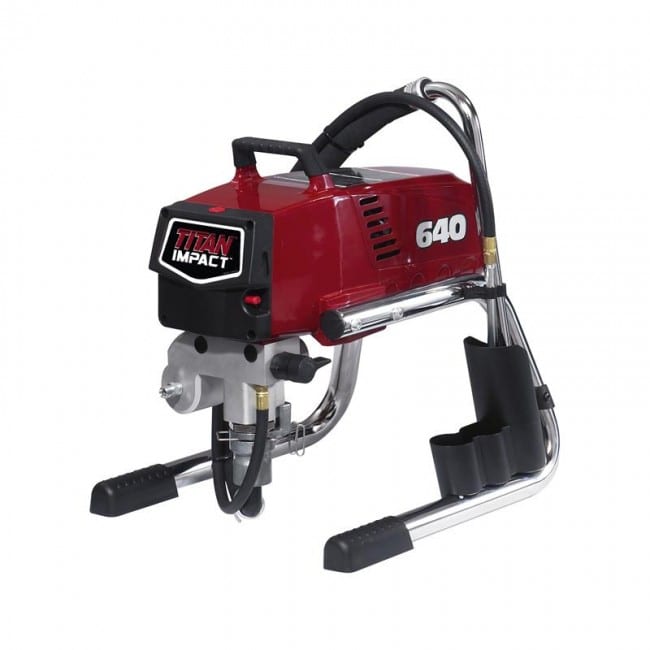Last month I was able to review a new Briggs & Stratton pressure washer which, as a professional painter of 35 years, is something I use quite a bit. This month the folks at Pro Tool Reviews handed me the Titan Impact 640 airless sprayer—a tool with which I happen to be very familiar, having owned both the Titan 440 airless sprayer and the low rider version of the 640. I even had a job that was just perfect for testing this tool: priming a couple of newly renovated homes. These are the same homes. In fact, I prepped for this very job using the Briggs & Stratton.
Titan Impact 640 First Impressions
As I mentioned, I’ve owned and used the skid version of this sprayer (no wheels). One nice thing about the high rider model is that you can just tilt it back and roll it when you need to relocate. I moved it around quite a bit, having to circumnavigate two homes several times. The 10-inch semi-pneumatic tires are nice and big, and they handled tree roots, deep ruts and just about everything else this pre-landscaped job site threw at it. This is a far cry from the consumer sprayers available on the market like the Wagner Power Painter Pro.
Editor’s note: See our article on choosing the right paint brush for the job
The thick telescopic handle pulls out easily and locks right into place. To collapse it you just have to push in the two spring-loaded pins, and it collapses right down. It doesn’t lock in the down position—which I think is good because it’s one less step when you’re ready to start working. There’s also a hose wrap built right into the top of the handle that will support up to 150′ of 1/4″ airless hose.
One thing you can’t miss is the DigiTrac LCD display located on the right side of the Impact 640. There are actually several menu screens that let you adjust the sprayer and monitor things like volume pumped and the hose pressure. You can also see how many hours you’ve put on the unit and even add a security code to prevent unauthorized use of the sprayer. I’m not sure why I’d lock down a sprayer, but the feature is there if you choose to use it. The screen will also indicate Prime when you set the pressure control knob at its minimum, or it will indicate Rapid Clean when you’ve got the sprayer set to that mode. Finally, the screen is a sort of readout for anything that might be going wrong with the system. It will tell you if there is low voltage, if the potentiometer or transducer is bad or if the motor is under a high mechanical load or is too hot. All in all, Titan seems to be doing its best to keep you from encountering a terminal failure with this sprayer. With a limited lifetime warranty, I suppose they better!
Maintenance Features that Work
The Impact 640 also comes with a Sureflo pusher valve. As someone who’s used many a hammer to unstick a lower ball valve, this is a feature I can appreciate. There’s also an oiler button on the front of the unit that sends oil from the reservoir directly to the packings. Titan recommends this about every eight hours of use.
The Business End of the Sprayer
Airless sprayers vary mostly at the pump end, where different models will allow for various pressures and capabilities. The Impact 640, for example, won’t spray thick elastomeric paint. (Titan makes models like their Advantage series that will.) If you have a good spray gun, many of these airless sprayers will feel the same regardless of what model you’re using. The LX-80 spray gun (which comes with the 640) is their four-finger model, and it’s a great gun that has been around forever. While there is a lock to keep it closed, the high pressure of the system makes it a bit of a safety hazard to include a way to lock it in the open position (for when cleaning it out). Some guys, when running water through the system at the end of the day, will stick a tennis ball in the handle to keep it open. I’m not going to endorse that, but it’s one of those things I’ve observed.
Don’t Forget to Tip!
I have always really liked Titan’s spray tips. In fact, I’ve used their new TR2 dual tips that have a fine tip for things like spindles, and a flip side for more broader applications. Our review sample came with a single 517 reversible tip which is good for ceilings or places where you’d need less overspray control. You get a lot of volume on a tip like this. I also noticed that the numbers on the tips seem to be imprinted deeper into the plastic than in years prior. That makes it easier to identify them after they get blessed with the inevitable coating of paint. For my work which in this case involved painting the porch railings on two newly renovated homes, I installed a 415 tip which gave me some better control and a narrower spray band. Since I was priming at this stage, this was the perfect tip. For painting the final coating on the porch spindles I’ll likely switch to a 413.
Working the Sprayer
This project started by straining the Valspar primer I was using through a mesh screen to remove any impurities that might be present (this primer was donated from Habitat for Humanity—see our sidebar for more on that). Before I could get to work I cleaned out the system to remove the fluid that comes in the unit to protect it from corrosion during storage and shipping. I then primed the unit. Priming took a long time due to the fact that it comes with a 50 foot long 3300 psi hose. I also purchased and attached a 5ft whip to give me some flexibility when using the LX-80 airless gun. In my opinion, every sprayer that’s even remotely pro-level should come with a whip as I don’t know anyone who’d paint without one (too stiff).
A Brush with Kindness
Because the paint used on these two renovated homes was donated by Valspar and came to us through Habitat for Humanity’s A Brush with Kindness program, I thought it would be good to outline a little bit about that program in thanks for their participation.
Habitat for Humanity helps families rebuild their lives by providing decent shelter. They’re in more than 90 countries, including all 50 of the United States, and are involved in natural disaster response, new home construction and home rehabilitation. Valspar, in addition to having donated more than $35 million in cash and in-kind contributions, is the driving force behind A Brush with Kindness, an innovative urban revitalization program run in conjunction with Habitat. A Brush with Kindness assists low-income families in repairing and renovating their homes. These projects include painting, landscaping, weatherization and minor repairs.
For our project, Habitat for Humanity’s A Brush with Kindness program donated both paint and primer from Valspar to renovate and restore two inner-city homes. These homes were renovated by a separate inner-city ministry that works closely with Habitat in order to team up on local neighborhood revitalization opportunities.
I’m not sure about other professional painters, but I almost always use a sprayer. It doesn’t matter whether I’m back rolling or brushing—the sprayer is my most important tool because it gets the paint on the material without me having to dip a brush or use a pan. In my book, painting is all about application, manipulation, distribution and finish. The first step is getting it on there. Then you want to distribute it evenly and make sure you’re using the right brush or roller to get that finished look you want.
For the railings on these early-1900’s bungalows, I applied two coats of primer, and I brushed those to get a nice even coating. Alternating between the LX-80 spray gun and my brush, I was able to work quickly and efficiently. By adjusting the pressure going through the system (using the large pressure control knob) I was able to dial in a comfortable pace for applying paint. I ended up somewhere just over 2000 PSI and it let me move the gun back and forth as needed in a way that applied the paint evenly and never puddled up or forced me to move faster or slower than I wanted. The job got done quickly and I saved a ton of time.
Which Configuration are You?
The Titan Impact Series sprayers are all available in multiple configurations. Models 440 through 640 can be purchased as a Skid, High Rider or Low Rider and models above that can be purchased as either High Rider or Low Rider. (The larger sprayers are heavier and too impractical to move around without wheels.)
Titan Impact 640 Specifications
- Model: Impact 640 (805-004)
- Delivery: 0.70 GPM (max)
- Max. Tip Size: 0.027 in.
- Motor: 1.55 hp DuraLife Brushless HE
- Operating Pressure: 3300 PSI (max)
- Weight (high rider): 69 lbs.
- Weight (low rider): 64 lbs.
- Weight (skid frame): 42 lbs.
- Warranty: 4-year limited; Limited lifetime (motor, drivetrain)
- Includes: LX-80 II gun, 517 TR1 tip, 1/4″ x 50′ airless hose
- Price: $1800

